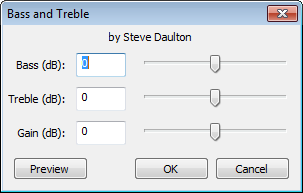Bass and Treble
From Audacity Manual
Bass (dB)
The amount of gain (amplification above 0 dB or attenuation below 0 dB) to bass (low) frequencies. Set this to a positive amount to boost the bass, or to a negative amount to reduce the bass. Bass gain is applied to frequencies lower than 1000 Hz, with the most gain being applied to frequencies about 100 Hz or lower.
Treble (dB)
The amount of gain (amplification above 0 dB or attenuation below 0 dB) to treble (high) frequencies. Set this to a positive amount to boost the treble, or to a negative amount to reduce the treble. Treble gain is applied to frequencies higher than 1000 Hz, with the most gain being applied to frequencies above 10000 Hz.
Gain (dB)
This is like a "volume" control that adjusts the overall level. Applying boost to the bass or treble will tend to increase the overall level, especially when boosting the bass. As a result, the overall level may be pushed so high that it distorts (clips). Similarly, reducing the bass or treble may cause the overall level to be too quiet. This control allows the overall level to be adjusted to compensate for excessive change in the overall level.
- When adjusting the Gain, press to hear how loud or quiet the resulting audio is.
- When audio sounds "tinny" or "nasal", this may be because the middle frequencies are too high. To counteract an excess of middle frequencies, try increasing both bass and treble and reducing the gain a little.
Technical details
Bass and Treble is a 2 band Equalizer.
- The Bass control is a low-shelf filter with the half gain frequency at 250 Hz and
- The Treble control is a high-shelf filter with the half gain frequency at 4000 Hz.
- All controls have a gain range of +/- 15 dB.
